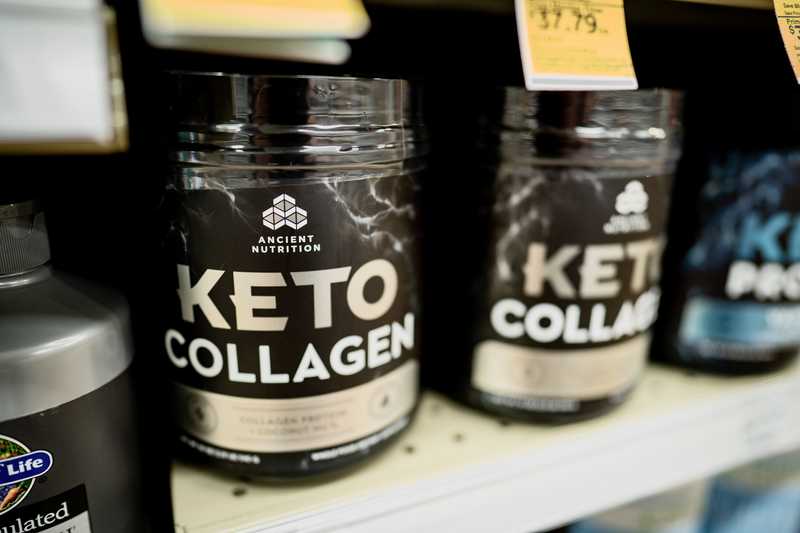If you have walked down the aisles of Walgreens, Target, or even Trader Joes, you may have noticed the increasing variety of collagen supplement powders. Or, perhaps you have a friend that has been raving adding collagen—how adding it to their morning coffee made their hair and nails grow incredibly fast, relieved pain in their joints, and even win the lottery!
Ok, you won't win the lottery, but are the other benefits true? Can collagen actually improve joint pain?
Table of Contents
- What is Collagen?
- Types of Collagen
- Collagen vs. Gelatin
- Foods with Collagen
- Collagen Benefits
- Collagen Side Effects
- The Verdict
What is Collagen?
Collagen is a crucial element of skin and connective tissues. Over time, lifestyle factors such as consuming excess sugar and processed carbohydrates, smoking, and sun exposure can cause reduced elasticity in cartilage, tendons, ligaments and skin. This not only leads to wrinkles, but soft tissue and joint discomfort too. Each collagen molecule takes the form of a triple helix (3 stranded spiral) made up of a repeated sequence of three amino acids. When the triple helix structure is heated or hydrolyzed, it unwinds and forms smaller molecules. It is then dehydrated and packaged. The hydrolyzing process is why collagen powders are also known as hydrolyzed collagen, collagen hydrosylate, or collagen peptides.
Types of Collagen
There are 16 different types of collagen, but you really only need to know about the first 3:
- Type I: makes up tendons, ligaments, fascial tissue, hair, skin
- Type II: found in elastic cartilage and helps cushion joints
- Type III: found in muscles, organs, and arteries
Most collagen powders are primarily Type I and III and made from beef. Sometimes they also contain fish, chicken, and eggshell. If you want to focus solely on joint health, choosing an encapsulated collagen supplement made only of Type II collagen may be your best option. Type II or 'Native' collagen supplements are made solely from chicken and are therefore appropriate for people who do not eat beef or eggs.1
There is also marine collagen for pescatarians, or people who choose to not eat any meat or poultry. I have not tried it, but a few patients who have say it's mostly flavorless, just like other collagen powders.2
Collagen vs. Gelatin
What's the difference between collagen and gelatin? Despite being made from the same amino acids (proteins) the hydrolyzation process means that that collagen powders will not gel. So you can add it to coffee or a smoothie and not end up with coffee jello. Gelatin, however, will gel. The jiggly clear liquid you get in the bottom of your Tupperware the day after cooking a turkey or pork roast—that's gelatin. The fruity Jello jigglers you ate as a kid—that's also gelatin.
Foods with Collagen
Yes, you can add collagen powder to your coffee, tea, or other liquids, but you can also eat it from its original form: meat. Try including these foods regularly to reap the benefits of their protein, fat, and collagen content:
- Chicken wings and chicken skin
- Beef or pork roasts cooked on the bone
- Turkey Legs
- Pork rinds (my favorite brands are Epic and 4505)
- Bone Broth or high quality stock3
Collagen Benefits
I could go down a rabbit hole discussing all the potential benefits of consuming collagen, but for the purpose of this article, I'm sticking with joint pain reduction.
In 2008, researchers from Penn State University studied 72 athletes taking 10g of collagen hydrosalate for 24 weeks. Another 74 athletes took a placebo. Despite only 97 participants completing the study, the collagen group was found to have significantly improved pain. When a subgroup analysis of subjects with knee arthralgia (n = 63) was performed, the difference between the effect of collagen hydrolysate vs. placebo was even more pronounced.4
A recently published 2021 clinical study of 180 young adults supplemented with 5g of Bioactive Collagen Peptides (a.k.a collagen hydrolysate) over 12 weeks. Forty-four percent reported knee pain in both knees, while 56% suffered from knee pain either in the left (25%) or right (31%) knee. According to the medical history, endurance exercises, team sports and fitness training were the main activities leading to knee pain. The results found a significant reduction in joint pain during exercise in the BCP group vs the placebo group.5
What about the older population? In 2012, researchers published a study of 200 50-year-old patients who were given either 1200mg of collagen hydrolysate or a placebo for 6 months. Participants were considered to have experienced significant improvement in symptoms if their pain decreased by 20% based on their VAS (visual analog scale) score. At 3 months there was no significant difference between the groups, but at 6 months 51.6% of the collagen group had significant improvement in symptoms vs 36.6% in the placebo group.6
Collagen Side Effects
There may be a risk of developing kidney stones from consuming excess collagen powders and supplements. Limiting your daily supplemental collagen intake to 10-20g is typically safe. Consuming 30g or more may increase your risk for oxalate kidney stones. If you have a condition like primary hyperoxaluria, you may want to avoid consuming high amounts of collagen due to its high proline content which is converted into oxalates in the kidneys.7
Rarely, people who are very sensitive to Monosodium Glutamate (MSG) may experience symptoms since collagen is high in free glutamic acid.8
The Verdict
So, if you are struggling with knee, hip, elbow or wrist pain it might be worth it to try adding collagen to your diet. As the studies have shown, this is not a quick fix. You might begin to experience improvements in 3 months, but 6 months is probably a better milestone to judge your progress. Most supplements on the market use 10-20g of collagen per serving, which for most people will be fine. This is also not a case of "more is better" so stick with one serving per day of supplemental collagen. Besides a hot or cold beverage, you can also add collagen powder to applesauce, pudding, spaghetti sauce, soups, cereal milk, or cooking rice. Don't want to deal with powders? Remember there are also Type II collagen supplements on the market.9 So do what works best for you!
Before you go, please read our disclaimer. This blog is intended for informational purposes only. We are not providing legal or medical advice and this blog does not create a provider-patient relationship. Always seek the help of a qualified medical professional who has assessed you and understands your condition.
References
Footnotes
-
Bakilan F, Armagan O, Ozgen M, Tascioglu F, Bolluk O, Alatas O. Effects of native type II collagen treatment on knee osteoarthritis: A randomized controlled trial. Eurasian J Med. 2016;48(2):95-101. https://www.ncbi.nlm.nih.gov/pmc/articles/PMC4970562/ ↩
-
Marine Collagen Peptides, accessed 20 May. https://www.vitalproteins.com/products/marine-collagen-peptides ↩
-
Goldberg E. Bone broth vs. Stock: Finally, we know the difference. Bon Appétit. Published January 12, 2017. Accessed May 19, 2021. https://www.bonappetit.com/story/difference-between-bone-broth-and-stock ↩
-
Clark KL, Sebastianelli W, Flechsenhar KR, et al. 24-Week study on the use of collagen hydrolysate as a dietary supplement in athletes with activity-related joint pain. Curr Med Res Opin. 2008;24(5):1485-1496. https://pubmed.ncbi.nlm.nih.gov/18416885/ ↩
-
Zdzieblik D, Brame J, Oesser S, Gollhofer A, König D. The influence of specific bioactive collagen peptides on knee joint discomfort in young physically active adults: A randomized controlled trial. Nutrients. 2021;13(2):523. https://www.mdpi.com/2072-6643/13/2/523/htm ↩
-
Bruyère O, Zegels B, Leonori L, et al. Effect of collagen hydrolysate in articular pain: a 6-month randomized, double-blind, placebo controlled study. Complement Ther Med. 2012;20(3):124-130. https://pubmed.ncbi.nlm.nih.gov/22500661/ ↩
-
Knight J, Jiang J, Assimos DG, Holmes RP. Hydroxyproline ingestion and urinary oxalate and glycolate excretion. Kidney Int. 2006;70(11):1929-1934. https://www.ncbi.nlm.nih.gov/pmc/articles/PMC2268952/ ↩
-
Ao J, Li B. Amino acid composition and antioxidant activities of hydrolysates and peptide fractions from porcine collagen. Food Sci Technol Int. 2012;18(5):425-434. https://www.semanticscholar.org/paper/Amino-acid-composition-and-antioxidant-activities-Ao-Li/307df88fc04758f44826dc86046f66bf4d62728b ↩
-
Jarrow Formulas Type II Collagen Complex, accessed 17 May. https://jarrow.com/products/type-ii-collagen-complex-60-capsules ↩

Brenna holds a Master's in Applied Nutrition from Northeastern University in Boston and a Bachelors of Science in Dietetics from Minnesota State University, Mankato. She is passionate about teaching people how foods interact with their body and helping them learn how what they eat affects how they feel.

Brenna holds a Master's in Applied Nutrition from Northeastern University in Boston and a Bachelors of Science in Dietetics from Minnesota State University, Mankato. She is passionate about teaching people how foods interact with their body and helping them learn how what they eat affects how they feel.




